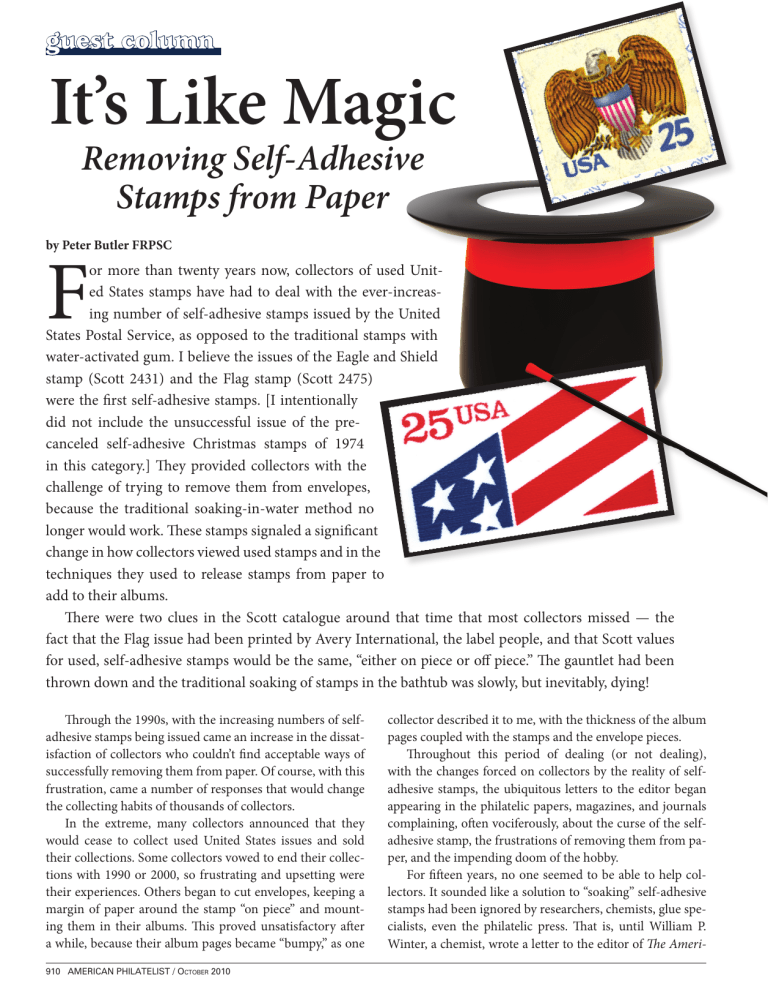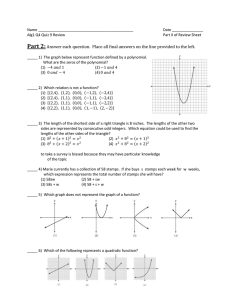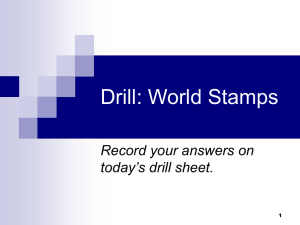Removing Self-adhesive Stamps from Paper

guest column
It’s Like Magic
Removing Self-adhesive
Stamps from Paper
by Peter Butler FRPSC F or more than twenty years now, collectors of used United States stamps have had to deal with the ever-increasing number of self-adhesive stamps issued by the United
States Postal Service, as opposed to the traditional stamps with water-activated gum. I believe the issues of the Eagle and Shield stamp (Scott 2431) and the Flag stamp (Scott 2475) were the first self-adhesive stamps. [I intentionally did not include the unsuccessful issue of the precanceled self-adhesive Christmas stamps of 1974 in this category.] They provided collectors with the challenge of trying to remove them from envelopes, because the traditional soaking-in-water method no longer would work. These stamps signaled a significant change in how collectors viewed used stamps and in the techniques they used to release stamps from paper to add to their albums.
There were two clues in the Scott catalogue around that time that most collectors missed — the fact that the Flag issue had been printed by Avery International, the label people, and that Scott values for used, self-adhesive stamps would be the same, “either on piece or off piece.” The gauntlet had been thrown down and the traditional soaking of stamps in the bathtub was slowly, but inevitably, dying!
Through the 1990s, with the increasing numbers of selfadhesive stamps being issued came an increase in the dissatisfaction of collectors who couldn’t find acceptable ways of successfully removing them from paper. Of course, with this frustration, came a number of responses that would change the collecting habits of thousands of collectors.
In the extreme, many collectors announced that they would cease to collect used United States issues and sold their collections. Some collectors vowed to end their collections with 1990 or 2000, so frustrating and upsetting were their experiences. Others began to cut envelopes, keeping a margin of paper around the stamp “on piece” and mounting them in their albums. This proved unsatisfactory after a while, because their album pages became “bumpy,” as one
910 AmericAn PhilAtelist / O ctOber
2010 collector described it to me, with the thickness of the album pages coupled with the stamps and the envelope pieces.
Throughout this period of dealing (or not dealing), with the changes forced on collectors by the reality of selfadhesive stamps, the ubiquitous letters to the editor began appearing in the philatelic papers, magazines, and journals complaining, often vociferously, about the curse of the selfadhesive stamp, the frustrations of removing them from paper, and the impending doom of the hobby.
For fifteen years, no one seemed to be able to help collectors. It sounded like a solution to “soaking” self-adhesive stamps had been ignored by researchers, chemists, glue specialists, even the philatelic press. That is, until William P.
Winter, a chemist, wrote a letter to the editor of The Ameri-
can Philatelist explaining his ideas of a solution to the problem. The letter was published in the July 2008 issue and made mention of a solvent called Bestine and a pinch of talcum powder. That piece of information began a series of events and experiences that have forever changed my approach to self-adhesive stamps. They now are included in my United
States collection of used stamps, as clean and “ungummed” as any water-activated stamps prior to the 1990s. Here is my story.
Using Bestine To Remove Self-adhesives
Winter’s method involved using a solvent called Bestine, an eyedropper, paper towels, and talcum powder. I already had the last three items so I started my search at Michael’s, the craft supply store, for Bestine. I found a small 4-ounce tin of the solvent and hurried home to try out the experiment, as directed by William Winter in his letter. I was amazed at the easy procedures for releasing stamps from paper and, within no time at all, I was adding hinges to the stamps and mounting them in my albums. “This is too good to be true,” I thought. Why not write about my experiences and share the information with other collectors?” So I did.
I wrote four different articles over a period of two years as a contributor of a column, “Grassroots Philately,” in Canadian Stamp News . I received many letters of support and appreciation from readers, “You have saved my life!” was just one outrageous response. This past summer I gave a workshop at the Summer Seminar at the American Philatelic Center. The response was so great that I was asked to write an article for The American Philatelist . This article is a compilation of the information presented in my columns and information gained since they were written.
These are the steps that Winter laid down in his letter, as I remember them, with a few additional pieces of information to add clarity from my perspective:
• Use an eyedropper to “suck up” a small amount of
Bestine and apply it, a few drops at a time, to the envelope side — as opposed to the stamp side — of the piece. Use it sparingly. Allow it to soak through the paper, which becomes translucent quickly.
Turn the piece over, roll it slightly, and you will see a corner of the stamp come away from the paper.
Proceed to peel off the stamp slowly. This process takes only a few seconds. Wait too long and you will have to start again.
• Note that the paper has no adhesive on it. The adhesive is still on the stamp and, as you would expect, is still sticky. However, the solvent has broken down the adhesive sufficiently to not allow the re-application of the stamp anywhere. Carefully lay the stamp face down on a paper towel. Don’t worry if it curls, that is normal. After the Bestine has evaporated, (twenty minutes at the most), dip your finger in talcum powder, just a touch, and wipe it on the back of the stamp. The stickiness will disappear,
For collectors interested in the chemistry,
Bestine is a solvent, a hydrocarbon that contains a chemical called heptane.
ready to accept a hinge and be mounted in your album. The stamp never really “gets wet,” so drying is not a big issue. I often leave the stamps on paper overnight before using talc.
My colleague, Dick Osman, who I’ll introduce later, removes the stickiness by removing the glue entirely. He adds another drop or two of Bestine to the back of the stamp and then slowly scrapes off the adhesive onto a paper towel with the edge of an old credit card or something similar. This procedure works well and is a good alterative to talcum powder if you are not happy leaving the adhesive on the stamp. The best advice is to try both methods and decide what suits you best.
Actually, this process is faster than the normal soaking routine. Some collectors who use this method, like to store the stamps in stock sheets to let them completely dry out and loose any presence of either substance remaining. (Using odorless talc is wise, any notice of the Bestine is quickly gone.)
The best place to find Bestine is in art supply stores or craft supply stores. Building supply stores or hardware stores do not carry it. It also is available online.
For collectors interested in the chemistry, Bestine is a solvent, a hydrocarbon that contains a chemical called heptane. Bestine has been used for years in the graphic arts business, basically to separate papers, art pieces, photographs, and documents, etc. It evaporates quickly, leaves no residue, and has no side effects when used properly. The solvent was originally formulated for thinning rubber cement but has since been reformulated to remove inks, decals, and labels from all kinds of surfaces.
Here is a recently-found piece of information that will interest readers. We all remember the days when we used a special liquid and a black tray to identify watermarks.
The substance was made from benzene. That chemical was deemed very dangerous and was taken off the market, as were other chemicals such as carbon tetrachloride and lighter fluid that were used in the hobby for a variety of jobs. The main replacement chemical in watermark identification, now that
All solvents are flammable and care must be taken to use them responsibly.
When so used, they are safer than the previously employed substances.
O ctOber
2010 / AmericAn PhilAtelist 911
previous chemicals have been discontinued, is heptane — a much safer and easier substance to use. All solvents are flammable and care must be taken to use them responsibly. When so used, they are safer than the previously employed substances.
The surprise substance in all of this discussion is the use of an air-freshener to obtain the same result as Bestine.
Yes, that’s right, an air-freshener. And there’s a great story behind the finding of an air-freshener to do the same job!
Using an air-Freshener To
Remove Self-adhesives
Following the publication of my first column about Bestine, Dick Osman, from Glenville, Pennsylvania, my good friend, an outstanding philatelist, and a great stamp club advocate, thought he would go to the local Home Depot to find this miracle solvent. He approached a fellow in the orange apron at the information desk about where he might find Bestine, but was told they didn’t stock it anymore.
“What is it you want the solvent to do?” asked the clerk.
After Dick’s explanation the clerk responded, “Oh well, if that’s what you need, try Pure Citrus. That’s what we use for that job.” While walking to the location of the air-fresheners, he further explained that the spray was used by employees to remove sale stickers from items needing new stickers for the regular price, the following week. “Could this be happening?” thought Dick. After taking a canister of Pure Citrus home and using it to remove stamps, not freshen the house, he found that what the clerk has said was exactly correct, and it did the job as well as Bestine.
When Dick told me of his experience, I was flabbergasted. I found a similar air-freshener in Canada, at a
Home Depot store and it worked as
Dick had said it would with excellent results. The Canadian brand I use is called ZEP. It’s a familiar name in the cleaning business so I thought it probably would do the job. The brand names of Pure Citrus and ZEP airfresheners are not the only ones on the present market. However, they are a step up in price from the regular airfresheners and it is important that you find ones with the following contents.
They must first of all be non-aerosol .
That means there are no fluorocarbons used as the propellant, only compressed air. (That’s important as an environmental issue.) It must be a 100% natural product and it must be citrus based . You might wonder why the last two points are so important.
The answer lies in the chemical d-limonene. This “cleaner from nature” has as its major component oil pressed out of citrus fruit rind after the juicing process. The peel is subjected to a steam extractor and then condensed, leaving oil on the surface. The remaining substance is called technical-
During the Summer Seminar, Peter showed an eager group of students the steps to remove a self-adhesive from paper.
912 AmericAn PhilAtelist / O ctOber
2010
Dick Osman demonstrates his technique.
The students couldn’t wait to try it.
grade d-limonene. It now replaces a wide variety of products including methyl and ethyl alcohol, acetone and fluorinated solvents, to name a few, and works well as a cleaner and adhesive remover and is a very safe, versatile chemical that can be used in many applications. This last bit of information comes from the website of the
Florida Chemical Company Inc. Try entering d-limonene in Google. You can read a host of articles on this wondrous chemical and how it is used today in so many ways. We can now add “used in removing self-adhesive stamps easily and safely from envelopes” to the list of uses on a variety of websites.
As you might expect, both these
Success! Give it a try!
processes work equally well on selfadhesive stamps from other countries. Some Australian stamps are a little harder to remove but you will be successful, and England’s Machin stamps are easy to remove, even the newest high-value stamps with the four “U”-shaped die cuts. This is despite threats of disaster if removal is attempted. The two methods make the removal of stamps with holograms easy and the holograms do not end up cracked or creased as they do when water is used.
Conclusions
Most of us have grown up with a healthy respect for using chemicals on stamps. My mentor used to whisper in my ear that he used a tablespoon of Javex in the water when soaking stamps. “It freshens the stamps,” he would say, “but don’t tell anybody, they wouldn’t approve.” Certainly, liquids for watermark identification were only used sparingly and with great care. Those who used lighter fluid or carbon tetrachloride to remove ballpoint pen or scotch tape did so in secret, because the chemicals were toxic and very flammable. There was no place for chemicals in philately.
But that was then and this is now.
The chemicals we are advocating are much safer and easier to use and, remember, the stamps of today are far more resilient with their plastic coatings and special varnish finishes than the classic stamps prior to the 1920s.
There are no fugitive inks on modern stamps, and the fears of mounts destroying stamps and substances migrating to covers from plastic sleeves are not a part of modern philately and the non-reactive materials we now use.
Bestine and air-fresheners are not about removing classical stamp from covers, they are about recovering today’s self-adhesive stamps — a reality in modern philately — from paper so they can be displayed in albums in excellent condition. A condition that cannot be accomplished by soaking in water with its resulting thinned paper, glue residue, discoloration, and the wasting of hours of time re-soaking with little pleasing results.
Pick up a non-aerosol, all natural, citrus-based air-freshener, and a tin of Bestine. Raid the medicine cabinet for a little talcum powder and an eyedropper, and you are ready for a very gratifying experience with many new issues. Your
U.S. collection will be the better for it and you will be back in business with handsome used stamps in your albums.
T he author
Peter Butler is a Fellow of the Royal Philatelic Society of Canada and its Executive Director at the National Office.
Peter also is a frequent instructor and longtime-student at the aPS Summer Seminar.
O ctOber
2010 / AmericAn PhilAtelist 913

